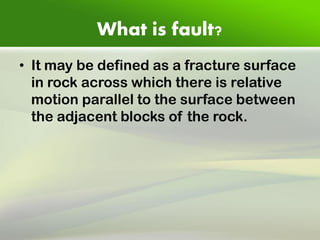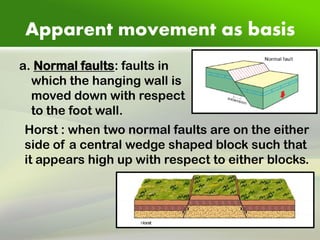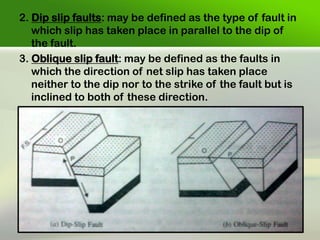Faults
- 2. What is fault? •It may be defined as a fracture surface in rock across which there is relative motion parallel to the surface between the adjacent blocks of the rock.
- 3. Fault terminology •Fault plane: it is the planer surface along which relative displacement of blocks takes place during the process of faulting.
- 4. •The walls: 1.Hanging wall: it is the term used for the faulted block which lies on the upper surface of the fault plane. 2.Foot wall: it is the term used for the faulted block which lies on the under surface of the fault plane.
- 5. •Slip and separation: slip may be defined as the relative motion of rock blocks along fault planes. 1.Strike slip: the slip that occurs along the direction of the strike of fault plane. 2.Dip slip : the slip that occurs along the direction of the dip of the fault plane. 3.Oblique slip: the slip that occurs both in dip and strike direction i.e. it is combination of strike and dip direction.
- 6. •Separation: The amount of apparent offset of a faulted surface, measured in specified direction. There are strike separation, dip separation, and net separation. 1.Heave: The horizontal component of dip separation measured perpendicular to strike of the fault. 2. Throw: The vertical component measured in vertical plane containing the dip.
- 7. Classification of faults •Following are the factors commonly considered important : 1.The apparent movement of the rock blocks along the fault plane. 2.The direction of the slip. 3.The relation of the fault altitude with the altitude of the displaced bed
- 8. Apparent movement as basis a. Normal faults: faults in which the hanging wall is moved down with respect to the foot wall. Horst : when two normal faults are on the either side of a central wedge shaped block such that it appears high up with respect to either blocks.
- 9. •Graben: when two normal faults are on the either side of a wedge shaped block such that it appears downwards with respect to either blocks. b. Reverse faults: this type of fault in which the hanging wall appears to have moved up with respect to the foot wall and dips at the angle more than 45 degrees.
- 10. •Thrust fault: these are variety of reverse faults in which the hanging wall has moved up with respect to footwall and the fault dip at the angle below 45 degrees. c. Strike – slip faults: it may be defined faults in which the faulted blocks have been moved against each in the horizontal direction along strikes. There are two types of strike – slip faults: 1. Right lateral strike-slip fault (dextral): Where the side opposite the observer moves to the right. 2.Left lateral strike-slip fault (sinistral): Where the side opposite the observer moves to the left.
- 11. On the basis of altitude (dip and strike) •Strike faults: faults that develop parallel to the strike of strata. In other words, the strike of the fault and that of disrupted layers are essentially parallel.(figure a) •Dip faults: faults that develop parallel to the dip of the strata. In other words, the fault strike is parallel to the dip of layers disrupted by faults. (figure b) •Oblique faults: faults whose strike makes an oblique angle with the strike of the rock in which it has caused the displacement. (figure c)
- 12. Mode of occurrences as basis a.Parallel faults: a group of normal faults occurring in the close proximities having same dips and strikes. when this group gives step like stricture in the structure then it is called step faults. (figure a)
- 13. b. Enechelon faults: Faults that are approximately parallel one another but occur in short unconnected segments, and sometimes overlapping. (figure b) c. Peripheral faults: when in any region the majority of faults are concentrated along the border or margin of the area. (figure c) d. Radial faults: the group of fault that appear emerging outward from a common point is called radial faults. (figure d)
- 14. On the basis of slip 1.Strike slip fault: it may be defined faults in which the faulted blocks have been moved against each in the horizontal direction along strikes. •They are called by other names under which they occur: a)Wrench fault: it is the strike slip faults in origin in which fault plane has developed transverse to the regional structure and even the net slip is in the same manner. The dip of the fault is very steep, nearly vertical. b)Transform faults: these are the strike slip faults that occur in the oceanic ridges. c)Tear faults: these are strike slip faults occurring in groups in continental regions that divide an originally extensive block into blocks of smaller and convenient dimensions.
- 15. There are three types of transform faults : •Ridge-Ridge transforms link two segments of a constructive plate boundary. •Trench-Trench transforms link two segments of a destructive plate boundary. •Ridge-Trench transforms link a constructive plate boundary to a destructive one.
- 16. 2. Dip slip faults: may be defined as the type of fault in which slip has taken place in parallel to the dip of the fault. 3. Oblique slip fault: may be defined as the faults in which the direction of net slip has taken place neither to the dip nor to the strike of the fault but is inclined to both of these direction.
- 17. Engineering consideration of faults •Faults cause very much shearing and crushing of rocks located in the fault zone making the rocks weak on one hand and porous, permeable on the other hand. •So following general conclusions can be drawn: I.The faulted rocks will form weak foundations for the dams. II.The fault zones will provide easy pathways for the water and causes leakage when left untreated in the dams. III.Once the fault zone becomes lubricated with water, the probability of further slipping becomes high. This may create critical condition within the foundation. IV.Faulting products like gouge and breccia create additional problems.
- 18. Please visit ( for more presentations) www.slideshare.net/RAHULSINHA1993


















